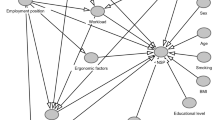Abstract
Background
The characteristics of neck and shoulder pain (NSP), called katakori in Japanese, have not been well documented to date. The aim of this study was to clarify the characteristics of NSP through a questionnaire survey of members of the nursing staff.
Methods
The study population consisted of 484 nursing staff members of Gunma University Hospital in Japan. The questionnaire involved information on age, body mass index (BMI), gender, psychological stress at work, musculoskeletal pain at other anatomic sites (elbow/wrist, lumbar and knee), smoking history, and hypertension. If subjects had NSP, they were asked about any coexisting symptoms, the utilization of health services, and the precise location of NSP.
Results
The total study population included 393 persons after 91 persons were excluded for various reasons. The point prevalence of NSP was 68.1% (268 of 393). Age, BMI, smoking history, and hypertension showed no significant trend for the prevalence of NSP in the univariate analyses. The occurrence of NSP was significantly higher in subjects with psychological stress, elbow/wrist pain, lumbar pain, and knee pain, respectively. A multivariate logistic regression analysis showed that gender, psychological stress, elbow/wrist pain, and lumbar pain were significantly associated with the occurrence of NSP. One hundred fifty-eight of those with NSP (58.9%) reported coexisting symptoms, and the most common was headache. Fifty-seven (21.2%) of the subjects with NSP had consulted medical or health practitioners, and bone setting was the most common service provider. The most common area of NSP was the superior part of the trapezius.
Conclusions
This study confirmed that NSP, katakori in Japanese, is a prevalent problem in a nursing staff, and several factors associated with NSP were identified.


Similar content being viewed by others
References
Statistics and Information Department, Ministry of Health, Labour and Welfare. Comprehensive survey of living conditions of the people on health and welfare 2004. Tokyo: Ministry of Health, Labour and Welfare; 2004. http://www.mhlw.go.jp/toukei/saikin/hw/k-tyosa/k-tyosa04/3-1.html.
Vogt MT, Simonsick EM, Harris TB, Nevitt MC, Kang JD, Rubin SM, Kritchevsky SB, Newman AB. Health, Aging and Body Composition Study. Neck and shoulder pain in 70- to 79-year-old men and women: findings from the Health, Aging and Body Composition Study. Spine J. 2003;3:435–41.
Mäkelä M, Heliövaara M, Sievers K, Impivaara O, Knekt P, Aromaa A. Prevalence, determinants, and consequences of chronic neck pain in Finland. Am J Epidemiol. 1991;134:1356–67.
Linton SJ. A review of psychological risk factors in back and neck pain. Spine. 2000;25:1148–56.
Carroll LJ, Hogg-Johnson S, Côté P, van der Velde G, Holm LW, Carragee EJ, Hurwitz EL, Peloso PM, Cassidy JD, Guzman J, Nordin M, Haldeman S. Bone and Joint Decade 2000–2010 Task Force on Neck Pain and its Associated Disorders. Course and prognostic factors for neck pain in workers: results of the Bone and Joint Decade 2000–2010 Task Force on Neck Pain and its Associated Disorders. Spine. 2008;33(4 Suppl):S93–100.
Andersson H, Ejlertsson G, Leden I. Widespread musculoskeletal chronic pain associated with smoking. An epidemiological study in a general rural population. Scand J Rehab Med. 1998;30:185–91.
Eriksen WB, Brage S, Bruusgaard D. Does smoking aggravate musculoskeletal pain? Scand J Rheumatol. 1997;26:49–54.
Palmer KT, Syddall H, Cooper C, Coggon D. Smoking and musculoskeletal disorders: findings from a British national survey. Ann Rheum Dis. 2003;62:33–6.
Bruehl S, Chung OY. Interactions between the cardiovascular and pain regulatory systems: an updated review of mechanisms and possible alterations in chronic pain. Neurosci Biobehav Rev. 2004;28:395–414.
Bruehl S, Chung OY, Jirjis JN, Biridepalli S. Prevalence of clinical hypertension in patients with chronic pain compared to nonpain general medical patients. Clin J Pain. 2005;21:147–53.
Bliss SJ, Flanders SA, Saint S. Clinical problem-solving a pain in the neck. N Engl J Med. 2004;350:1037–42.
Bracher ES, Almeida CI, Almeida RR, Duprat AC, Bracher CB. A combined approach for the treatment of cervical vertigo. J Manip Physiol Ther. 2000;23:96–100.
Hurwitz EL, Carragee EJ, van der Velde G, Carroll LJ, Nordin M, Guzman J, Peloso PM, Holm LW, Côté P, Hogg-Johnson S, Cassidy JD, Haldeman S. Bone and Joint Decade 2000–2010 Task Force on Neck Pain and its Associated Disorders. Treatment of neck pain: noninvasive interventions: results of the Bone and Joint Decade 2000–2010 Task Force on Neck Pain and its Associated Disorders. Spine. 2008;33(4 Suppl):S123–52.
Wolsko PM, Eisenberg DM, Davis RB, Kessler R, Phillips RS. Patterns and perceptions of care for treatment of back and neck pain: results of a national survey. Spine. 2003;28:292–7.
Takagishi K, Hoshino Y, Ide J, Sugihara T, Hata Y, Sano H, Hamada J, Yabuki S, Mochizuki Y, Suzuki K, Yanagawa T, Tamai K, Ogawa K, Atsuta Y, Shinozaki T. Project Study on katakori (2004–2006). J Jpn Orthop Assoc. 2008;82:901–11 (in Japanese).
Iijima K, Sasaki M, Katon W. Study of “katakori”. Nihon Ijishinnpou. 1992;3547:30–3. (in Japanese).
Yokogushi K, Yamashita T, Yokozawa H, Aoki M, Okamura K, Ishii S. Comparative study on neck and associated symptoms of outpatients of our clinic with general healthy people. East Jpn J Clin Orhop. 1994;6:419–23. (in Japanese).
Yabuki S, Kikuchi S. Pathogenesis of the neck and shoulder stiffness. Rinsho Seikei Geka. 2001;36:1241–6. (in Japanese).
Tada K, Yoshida T, Murase T. Cervicobrachial symdrome and shoulder stiffness. Rinsho Seikei Geka. 2001;36:1247–55. (in Japanese).
Fujita M, Yano T, Ohno Y, Sasai Y, Miura S, Tsuji S. The prevalence and the characteristics of shoulder stiffness and its relationship with mental stress and the general states evaluated according to the theory of oriental medicine among high school students. Health Sci. 2000;16:223–35. (in Japanese).
Shinozaki T, Osawa T, Tsutsumi S, Kobayashi T, Takagishi K. Clinical findings of chronic non-specific neck pain based on the questionnaire. Rinsho Seikei Geka. 2001;42:409–12. (in Japanese).
Conflict of interest
All authors certify they have no commercial associations that might pose a conflict of interest in connection with this article.
Author information
Authors and Affiliations
Corresponding author
About this article
Cite this article
Iizuka, Y., Shinozaki, T., Kobayashi, T. et al. Characteristics of neck and shoulder pain (called katakori in Japanese) among members of the nursing staff. J Orthop Sci 17, 46–50 (2012). https://doi.org/10.1007/s00776-011-0177-5
Received:
Accepted:
Published:
Issue Date:
DOI: https://doi.org/10.1007/s00776-011-0177-5




